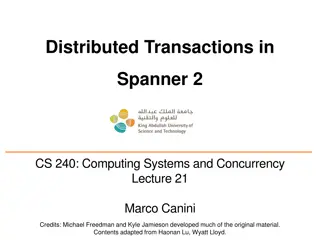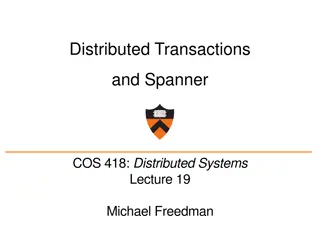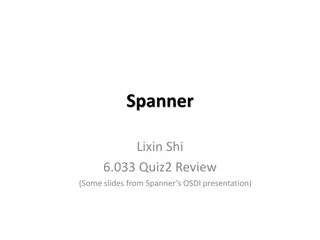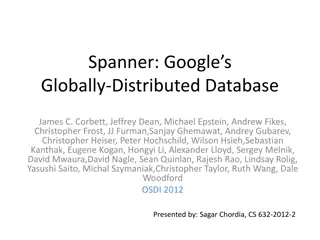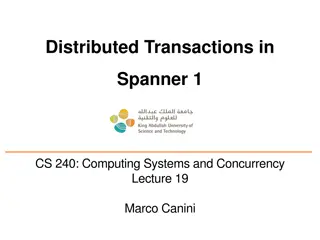
Spanner: Google's Globally Distributed Database Overview
Explore the features and implementation of Spanner, Google's globally distributed database system, designed for scale, multi-versioning, and synchronous replication across data centers. Learn how Spanner reshards data, supports schema-rich tables, and ensures global availability.
Download Presentation

Please find below an Image/Link to download the presentation.
The content on the website is provided AS IS for your information and personal use only. It may not be sold, licensed, or shared on other websites without obtaining consent from the author. If you encounter any issues during the download, it is possible that the publisher has removed the file from their server.
You are allowed to download the files provided on this website for personal or commercial use, subject to the condition that they are used lawfully. All files are the property of their respective owners.
The content on the website is provided AS IS for your information and personal use only. It may not be sold, licensed, or shared on other websites without obtaining consent from the author.
E N D
Presentation Transcript
Spanner: Googles Globally-Distributed Database - Presented by Chaitanya Uppuluri 1
Introduction Spanner is Google s scalable, multi-version, globally distributed, and synchronously- replicated database Multi-version : Independent of timestamp uncertainty. Globally Distributed: The data is distributed across the world. Synchronously-replicated: Changes in one replication reflect in the other synchronously. It is the first system to distribute data at global scale and support externally-consistent distributed transactions. Built, and deployed at Google - 2
Introduction Replication is used for global availability and geographic locality. Spanner automatically reshards data across machines, and data is automatically migrated across machines. Spanner is designed to scale up to millions of machines across hundreds of data centers and trillions of databases. Applications can specify constraints to control which datacenters contain which data. Data can also be dynamically and transparently moved between datacenters by the system to balance resource usage across datacenters. - 3
Introduction Many applications at Google have chosen to use Megastore. Because megastore consists of semi-relational data model. It also support for synchronous replication This made Spanner evolve from a Bigtable-versioned key-value store into a temporal multi-version database. Data is stored in schematized semi-relational tables. Each version is automatically time stamped with its commit time. Old versions of data are subjected to garbage-collection policies. - 4
Implementation A Spanner deployment is called a universe. Google currently runs a test/playground universe, a development/production universe, and a production-only universe. Each zone here, is the rough analog of a deployment of Bigtable servers. Zones are also accessed as locations but physically isolated. Zones can be added to or removed from a running system as new data centers are brought into service and old ones are turned off. - 5
Implementation The universe master is primarily a console that displays status information about all the zones for interactive debugging. The placement driver handles automated movement of data across zones on the timescale of minutes. The placement driver periodically communicates with the spanservers to find data that needs to be moved, either to meet updated replication constraints or to balance the load. - 6
Spanner server stack (key:string, timestamp:int64) string Each spanserver is responsible for between 100 and 1000 instances of a data structure called a tablet. >Timestamp mapping responsible for multi- verison in Spanner The tablet s state is stored in set of B-tree-like files and a write-ahead log, all on Colossus distributed file system. - Each spanserver implements a single Paxos state machine on top of each tablet. Each state machine stores its metadata and log in its corresponding tablet. The Paxos state machines are used to implement a consistently replicated bag of mappings. The key- value mapping state of each replica is stored in its corresponding tablet. 7
Spanner server stack At every replica, each spanserver implements a lock table for concurrency control. The lock table contains the state for two-phase locking: it maps ranges of keys to lock states. - At every replica, each spanserver also implements a transaction manager to support distributed transactions. The transaction manager is used to implement a participant leader. The other replicas in the group will be referred to as participant slaves. 8
Directory in Server Stack Directory is a set of contiguous keys that share a common prefix. When data is moved between Paxos groups, it is moved directory by directory. - Directories can be moved while client operations are ongoing, with MoveDir command. A 50MB directory can be moved in a few seconds. a directory is sharded into multiple fragments if it grows too large. Multiple directories that are frequently accessed together are collocated collectively together. A directory s geographic replication properties (placement) can be specified by the application that uses Spanner, by tagging each database and the directories. 9
Data Model Bigtable only supports eventually-consistent replication across datacenters. But Spanner s MegaStore data model supports synchronous replication across the datacenters. The data model is layered on top of the directory-bucketed key-value mappings supported by the implementation. - Tables look like relational-database tables, with rows, columns, and versioned values. The primary keys form the row names, and each table defines a mapping from the primary-key columns to the non-primary-key columns. A row becomes existent only if some value is associated with it. Applications that use MegaStore: Gmail, Picasa, Calendar, Android Market, and AppEngine. 10
Data Model The table at the top of a hierarchy is a directory table. Each row in a directory table with key K, together with all of the rows in descendant tables that start with K in lexicographic order, forms a directory. Dir user 1 , Dir User 2 Albums represent the rows - ON DELETE CASCADE indicates that deleting a row in the directory table deletes any associated child rows. Client applications declare the hierarchies in database schemas via the INTERLEAVE IN declarations. Query to create skeleton for dir Users and rows It allows clients to describe the locality relationships that exist between multiple tables. Spanner knows the most important locality relationships through INTERLEAVE IN. 11
True-Time API TrueTime explicitly represents time as a TTinterval. TTinterval is an interval with bounded time uncertainty, unlike standard time interfaces that give clients no notion of uncertainty. The time epoch is analogous to UNIX time with leap-second smearing. - TT.now( ) method returns a TTinterval that is guaranteed to contain the absolute time during which it was invoked. For an invocation : tt = TT.now( ) {tt.earliest t_abs(e_now) tt.latest}, [e_now is an event that occurred, t is the timestamp] Method Returns TT.now() TTinterval: [earliest, latest] TT.after(t) true if t has definitely passed TT.before(t) true if t has definitely not arrived 12
True-Time API The underlying time references used by TrueTime are GPS and atomic clocks. Two time references are used because each have different failure modes. TrueTime is implemented by a set of time master machines per datacenter and a timeslave daemon per machine. - The majority of masters have GPS receivers with dedicated antennas. These masters are separated physically to reduce the effects of antenna failures, radio interference, and spoofing. Rest use Armageddon master, that are equipped with atomic clocks. Between synchronizations, Armageddon masters advertise a slowly increasing time uncertainty that is derived from conservatively applied worst-case clock drift. GPS masters advertise uncertainty that is typically close to zero. 13
True-Time API Concurrency Control Guarantees that a whole-database audit read at a timestamp t will see exactly the effects of every transaction that has committed as of t. Timestamp Management The Spanner implementation supports readwrite transactions, read-only transactions and snapshot reads. The standalone writes are implemented as read-write transactions. The non-snapshot standalone reads are implemented as read-only transactions. - 14
True Time API - Paxos Leader Leases Spanner s Paxos implementation uses timed leases to make leadership long- lived (10 seconds by default). A potential leader sends requests for timed lease votes. Upon receiving a quorum of lease votes the leader knows it has a lease. A replica extends its lease vote implicitly on a successful write, and the leader requests lease-vote extensions if they are near expiration. A Paxos leader can abdicate by releasing its slaves from their lease votes. Before abdicating, a leader must wait until TT.after(Smax) is true where Smax is the maximum timestamp used by a leader - 15
True Time API - Assigning Timestamps to RW Transactions Spanner assigns timestamps to Paxos writes in monotonically increasing order, even across leaders. A single leader replica can trivially assign timestamps in monotonically increasing order. Spanner also enforces the following external consistency invariant. If the start of a transaction T2 occurs after the commit of a transaction T1, then the commit timestamp of T2 must be greater than the commit timestamp of T1. - 16
True Time API - Assigning Timestamps to RW Transactions START timestamp S_i no less than the value of TT.now( ).latest, computed after e server COMMIT WAIT - The coordinator leader for a write T_i assigns a commit timestamp S_i no less than the value of TT.now( ).latest, computed after e . - The coordinator leader for a write T_i assigns a commit - 17
True Time API - Server reads Every replica tracks a value called safe time tsafe which is the maximum timestamp at which a replica is up-to-date. A replica can satisfy a read at a timestamp t if t <= t_safe. - Define tsafe = min(t_safe for Paxos , t_safe for TM), where each Paxos state machine has a safe time t_safe for Paxos and each transaction manager TM has a safe time t_safe. 18
True Time API - Assigning Timestamps to RO Transactions A read-only transaction executes in two phases: assign a timestamp s_read, and then execute the transaction s reads as snapshot reads at s_read The simple assignment of s_read = TT.now( ).latest, at any time after a transaction starts, preserves external consistency by an argument - However, such a timestamp may require the execution of the data reads at s_read to block if tsafe has not advanced sufficiently To reduce the chances of blocking, Spanner should assign the oldest timestamp that preserves external consistency 19
Read Only and Read Write transactions In Read-Write transactions the client chooses a coordinator group and sends a commit message to each participant s leader with the identity of the coordinator and any buffered writes. The client drives the two-phase commit avoids sending data twice across wide- area links. - A non-coordinator-participant leader first acquires write locks. It then chooses a prepare timestamp that must be larger than any timestamps it has assigned to previous transactions (to preserve monotonicity), and logs a prepare record through Paxos. Each participant then notifies the coordinator of its prepare timestamp 20
Read Only and Read Write transactions The coordinator leader also first acquires write locks, but skips the prepare phase. It chooses a timestamp for the entire transaction after hearing from all other participant leaders. The coordinator leader then logs a commit record through Paxos. - After commit wait, the coordinator sends the commit timestamp to the client and all other participant leaders. Each participant leader logs the transaction s outcome through Paxos. All participants apply at the same timestamp and then release locks 21
Read Only and Read Write transactions For Read-only transactions, assigning a timestamp requires a negotiation phase between all of the Paxos groups that are involved in the reads. As a result, Spanner requires a scope expression for every read-only transaction. Scope expression summarizes the keys that will be read by the entire transaction. If the scope s values are served by a single Paxos group, then the client issues the read-only transaction to that group s leader. f the scope s values are served by multiple Paxos groups, the client avoids a negotiation round, and just has its reads execute at s_read = TT.now().latest. All reads in the transaction can be sent to replicas that are sufficiently up-to-date - 22
Schema-Change Transactions Atomic Schema-change transactions are used because it would be infeasible to use a standard transaction, because the number of participants could be in the millions. First, it is explicitly assigned a timestamp in the future, which is registered in the prepare phase. As a result, schema changes across thousands of servers can complete with minimal disruption to other concurrent activity. Second, reads and writes, which implicitly depend on the schema, synchronize with any registered schema-change timestamp at time t. - 23
- Mean and standard deviation over 10 runs and 1D means one replica with commit wait disabled. 24
Microbenchmarks For evaluation, each spanserver ran on scheduling units of 4GB RAM and 4 cores (AMD Barcelona 2200MHz) Clients were run on separate machines. Each zone contained one spanserver. Clients and zones were placed in a set of datacenters with network distance of less than 1ms. The test database was created with 50 Paxos groups with 2500 directories. Operations were standalone reads and writes of 4KB. All reads were served out of memory after a compaction, so that we are only measuring the overhead of Spanner s call stack. In addition, one unmeasured round of reads was done first to warm any location caches. - 25
Mean and standard deviations over 10 runs for Two- phase commit scalability Client - 26
Availability evaluation Non-leader kills Z2 server; (leader-hard) kills Z1 server; (leader-soft) kills Z1 server, giving notifications to all of the servers that they should handoff leadership other zone. - 27
TrueTime Evaluation Tail-latency issues that cause higher values of epsilon. Reduction in tail latencies beginning on March 30 were due to networking improvements that reduced transient network-link congestion. The increase in on April 13, approximately one hour in duration, resulted from the shutdown of 2 time masters at a datacenter for routine maintenance - 28
Future works Spanner s monitoring and support tools, as well as tuning its performance are being improved. In addition, Spanner has been working on improving the functionality and performance of the backup/restore system. Google Spanner is currently implementing the Spanner schema language, automatic maintenance of secondary indices, and automatic load-based resharding. Improvements to support direct changes of Paxos configurations are being planned. the node-local data structures have relatively poor performance on complex SQL queries Work should be done on the ability to move client-application processes between datacenters in an automated, coordinated fashion. - 30
Thank you - 31



